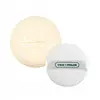What's inside
What's inside
 Key Ingredients
Key Ingredients

 Benefits
Benefits

 Concerns
Concerns

 Ingredients Side-by-side
Ingredients Side-by-side

Silica
AbrasiveZinc Oxide
Cosmetic ColorantBis-Hydroxyethoxypropyl Dimethicone
EmollientAluminum Starch Octenylsuccinate
AbsorbentSynthetic Fluorphlogopite
Triethoxycaprylylsilane
Glyceryl Caprylate
EmollientCaprylyl Glycol
EmollientCI 77492
Cosmetic ColorantWater
Skin ConditioningCentella Asiatica Extract
CleansingTocopherol
AntioxidantNiacinamide
Smoothing1,2-Hexanediol
Skin ConditioningSodium Hyaluronate
HumectantGlycerin
HumectantButylene Glycol
HumectantCitrus Junos Seed Extract
AntioxidantHippophae Rhamnoides Fruit Extract
Skin ConditioningAscorbic Acid
AntioxidantMadecassoside
AntioxidantAsiatic Acid
Skin ConditioningAsiaticoside
AntioxidantPropolis Extract
Skin ConditioningMadecassic Acid
Skin ConditioningSilica, Zinc Oxide, Bis-Hydroxyethoxypropyl Dimethicone, Aluminum Starch Octenylsuccinate, Synthetic Fluorphlogopite, Triethoxycaprylylsilane, Glyceryl Caprylate, Caprylyl Glycol, CI 77492, Water, Centella Asiatica Extract, Tocopherol, Niacinamide, 1,2-Hexanediol, Sodium Hyaluronate, Glycerin, Butylene Glycol, Citrus Junos Seed Extract, Hippophae Rhamnoides Fruit Extract, Ascorbic Acid, Madecassoside, Asiatic Acid, Asiaticoside, Propolis Extract, Madecassic Acid
Ingredients Explained
These ingredients are found in both products.
Ingredients higher up in an ingredient list are typically present in a larger amount.
Ci 77492 is also hydrated iron III oxide. It's sole purpose is to give a yellow hue to products.
Iron III oxides are classified as inorganic chemicals for coloring.
Synthetically created Ci 77492 is considered safer than those naturally found. This is because the synthetically created version may contain less impurities. Iron oxides are generally non-toxic and non-allergenic.
Learn more about CI 77492Niacinamide is a multitasking form of vitamin B3 that strengthens the skin barrier, reduces pores and dark spots, regulates oil, and improves signs of aging.
And the best part? It's gentle and well-tolerated by most skin types, including sensitive and reactive skin.
You might have heard of "niacin flush", or the reddening of skin that causes itchiness. Niacinamide has not been found to cause this.
In very rare cases, some individuals may not be able to tolerate niacinamide at all or experience an allergic reaction to it.
If you are experiencing flaking, irritation, and dryness with this ingredient, be sure to double check all your products as this ingredient can be found in all categories of skincare.
When incorporating niacinamide into your routine, look out for concentration amounts. Typically, 5% niacinamide provides benefits such as fading dark spots. However, if you have sensitive skin, it is better to begin with a smaller concentration.
When you apply niacinamide to your skin, your body converts it into nicotinamide adenine dinucleotide (NAD). NAD is an essential coenzyme that is already found in your cells as "fuel" and powers countless biological processes.
In your skin, NAD helps repair cell damage, produce new healthy cells, support collagen production, strengthen the skin barrier, and fight environmental stressors (like UV and pollution).
Our natural NAD levels start to decline with age, leading to slower skin repair, visible aging, and a weaker skin barrier. By providing your skin niacinamide, you're recharging your skin's NAD levels. This leads to stronger, healthier, and younger looking skin.
Another name for vitamin B3 is nicotinamide. This vitamin is water-soluble and our bodies don't store it. We obtain Vitamin B3 from either food or skincare. Meat, fish, wheat, yeast, and leafy greens contain vitamin B3.
The type of niacinamide used in skincare is synthetically created.
Learn more about NiacinamideSilica, also known as silicon dioxide, is a naturally occurring mineral. It is used as a fine, spherical, and porous powder in cosmetics.
Though it has exfoliant properties, the function of silica varies depending on the product.
The unique structure of silica enhances the spreadability and adds smoothness, making it a great texture enhancer.
It is also used as an active carrier, emulsifier, and mattifier due to its ability to absorb excess oil.
In some products, tiny microneedles called spicules are made from silica or hydrolyzed sponge. When you rub them in, they lightly polish away dead skin layers and enhance the penetration of active ingredients.
Learn more about SilicaSodium Hyaluronate is hyaluronic acid's salt form. It is commonly derived from the sodium salt of hyaluronic acid.
Like hyaluronic acid, it is great at holding water and acts as a humectant. This makes it a great skin hydrating ingredient.
Sodium Hyaluronate is naturally occurring in our bodies and is mostly found in eye fluid and joints.
These are some other common types of Hyaluronic Acid:
Learn more about Sodium Hyaluronate